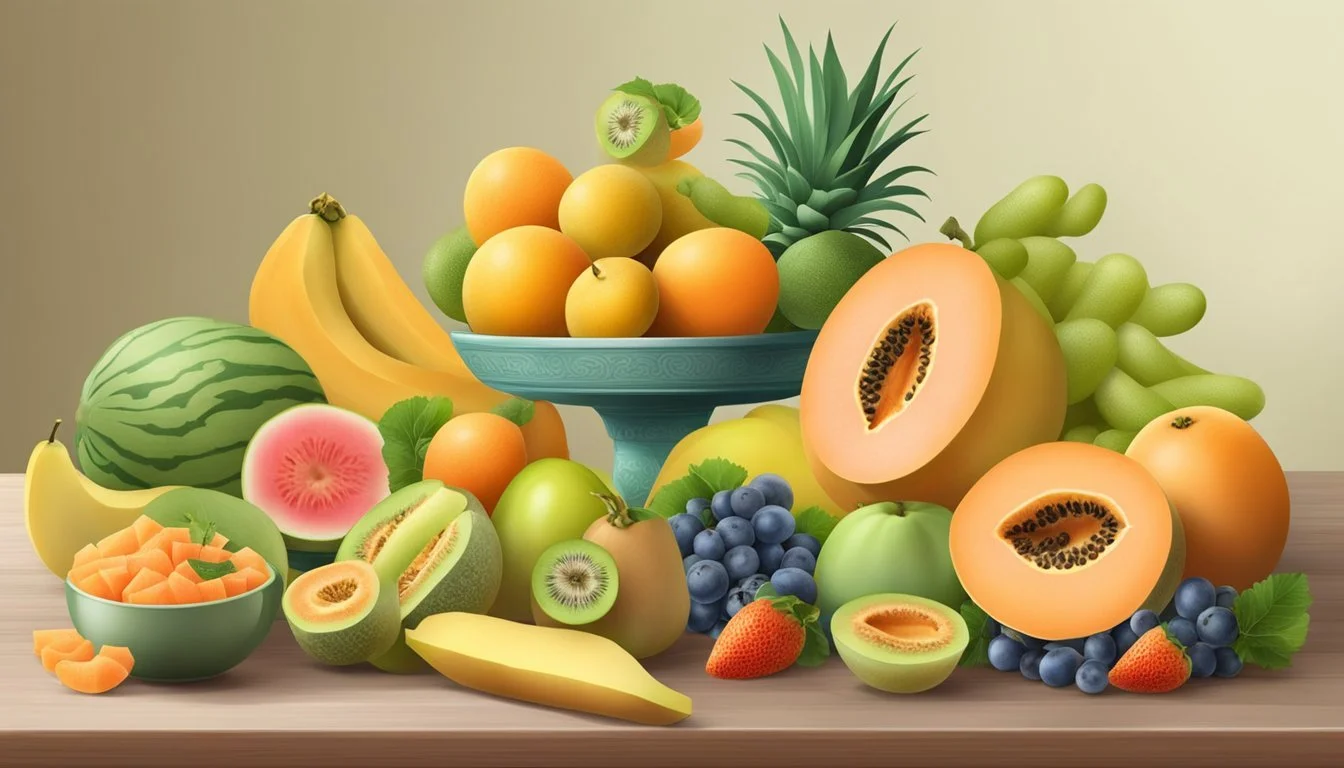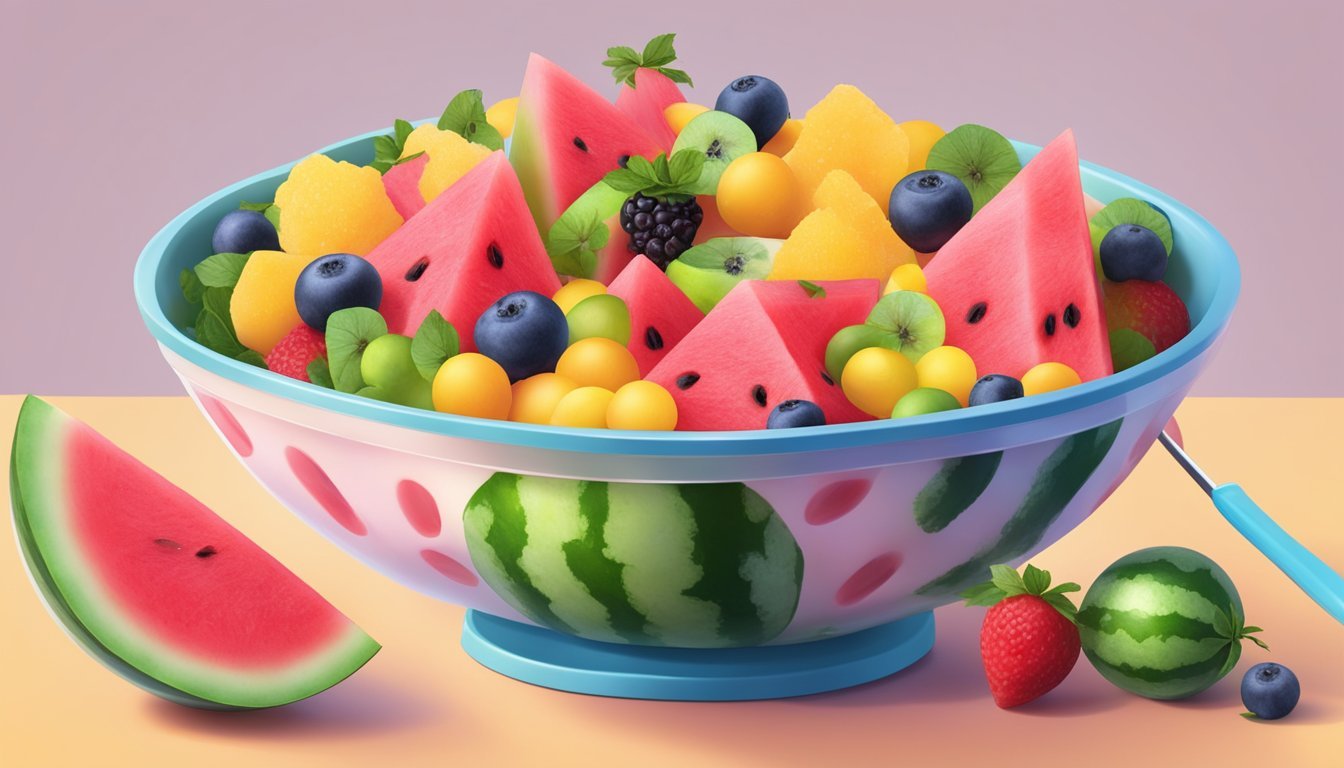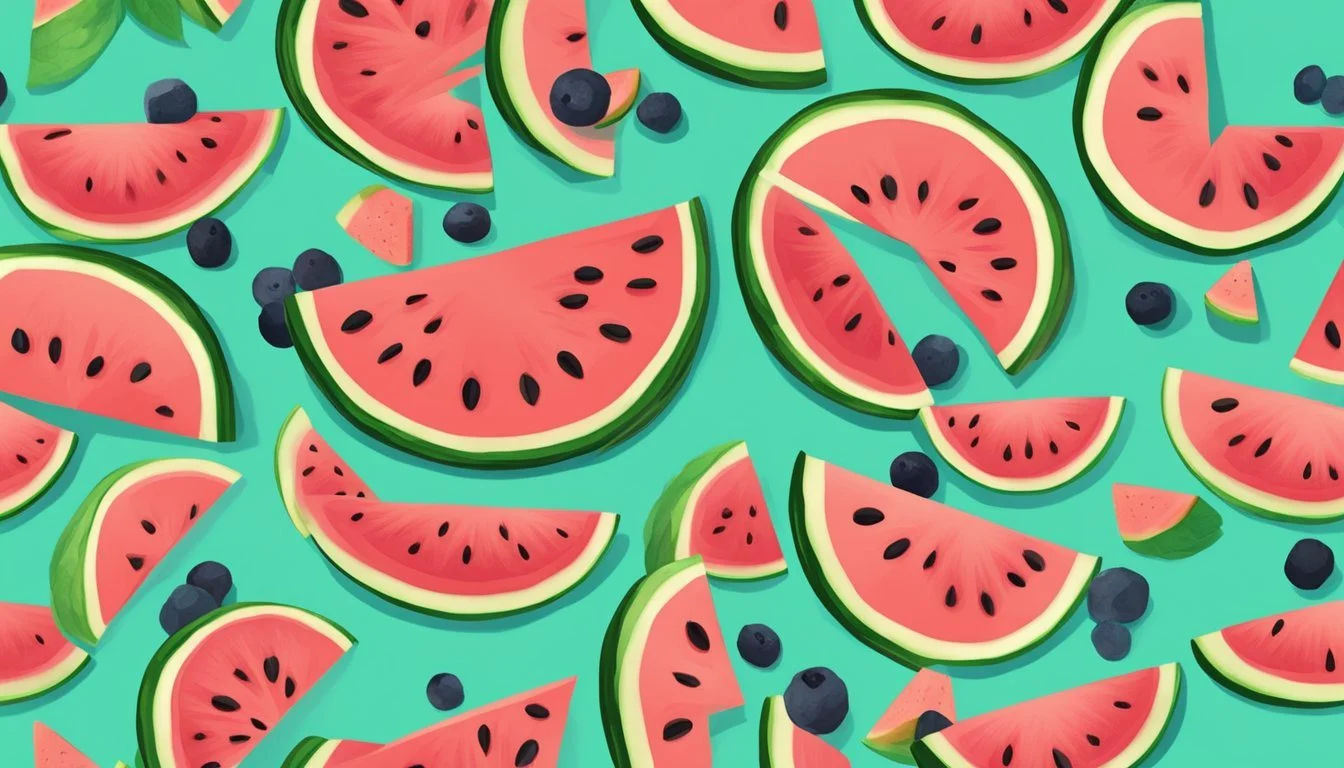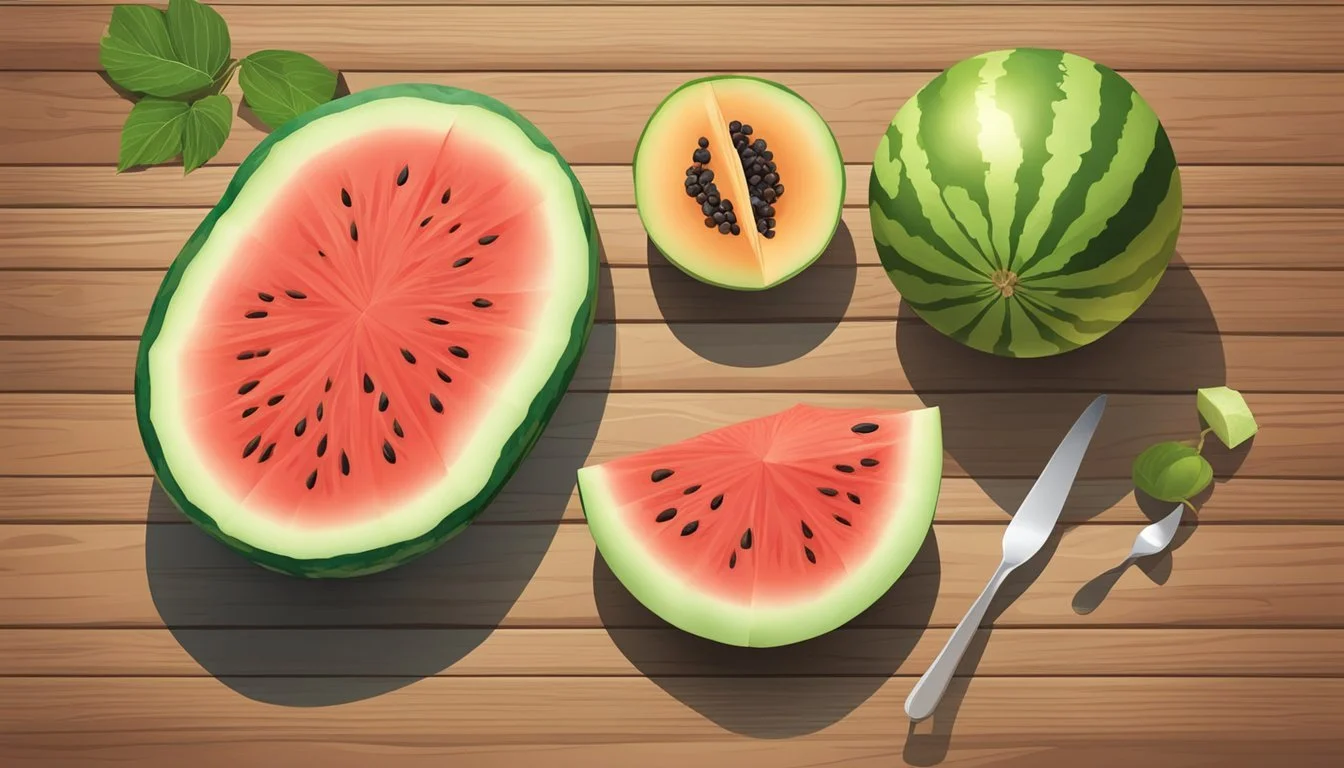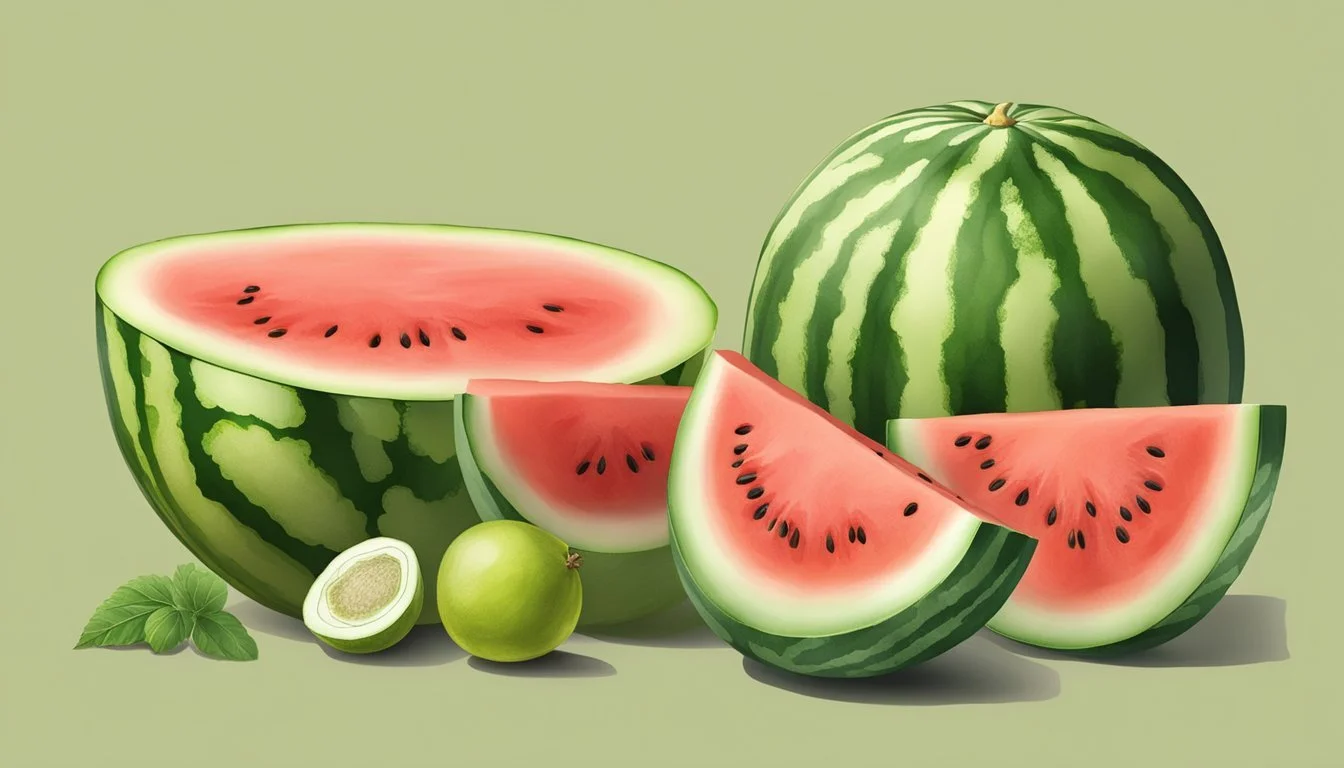Watermelon Substitutes
Best Alternatives for Flavor and Hydration
Finding a suitable substitute for watermelon can transform a recipe, ensuring that it still delivers a refreshing, juicy experience even when watermelon isn’t available. The best watermelon substitutes include fruits like guava, cactus fruit, red dragon fruit, pear, honeydew melon, cantaloupe, strawberries, and pineapple. Each of these alternatives offers a unique combination of flavor, texture, and nutritional benefits.
For those seeking a similar watery, sweet flavor, options like honeydew melon and cantaloupe are excellent due to their high water content and mild sweetness. When looking for a fruity punch with added nutritional benefits, strawberries and pineapples offer an abundance of antioxidants and vitamins. Guava and cactus fruit, though less common, can provide an exotic twist to your dishes with their distinctive flavors and textures.
These substitutes are not only delightful on their own but also versatile in various culinary applications, be it in salads, smoothies, or desserts. By experimenting with these alternatives, one can maintain the delicious essence of their recipes while exploring new flavor dimensions.
Understanding Watermelon Substitutes
Substituting watermelon requires consideration of various factors such as nutritional benefits, flavor, and texture to find suitable alternatives. Common substitutes include fruits like cantaloupe, honeydew, strawberries, and pineapple.
Why Substitute Watermelon?
Allergies or Sensitivities: Some individuals may experience allergic reactions or digestive sensitivities to watermelon, making it necessary to find alternatives.
Availability: Depending on the season or region, watermelon may not always be readily available, prompting the need for substitutes.
Recipe Requirements: Certain recipes may call for ingredients with a similar flavor profile but different textures or other specific qualities.
Nutritional Profile of Watermelon
Vitamins and Minerals: Watermelon is rich in vitamins A and C, which are crucial for maintaining skin health, vision, and immune function.
Hydration: Watermelon consists of approximately 92% water, making it excellent for hydration.
Fiber Content: Though not particularly high in fiber, watermelon still provides a modest amount, aiding digestion.
Low Calorie: It is low in calories, which makes it a favorable option for those seeking to manage their weight.
Texture and Flavor Characteristics
Flavor: Watermelon has a unique, sweet, and refreshing taste that is difficult to replicate exactly. It is less tart compared to other fruits like pineapple or strawberries.
Texture: The texture of watermelon is crisp and watery, setting it apart from fruits with denser or more fibrous textures such as pears or apples.
Versatility: This fruit's texture and flavor make it a popular choice for a variety of dishes, from salads to smoothies, and desserts.
By understanding these facets, one can make informed decisions about the best substitutes for watermelon, ensuring that nutritional and culinary needs are adequately met.
Fruit Substitutes for Watermelon
When watermelon is unavailable, there are several fruits that can effectively replace its watery, sweet flavor and nutritional benefits. These alternatives include melons like cantaloupe and honeydew, various berries, tropical fruits like mango and papaya, and certain citrus fruits and pineapple.
Cantaloupe and Honeydew Melon
Cantaloupe and honeydew melon are excellent substitutes for watermelon. Cantaloupe has a sweet flavor and high water content, making it refreshing and hydrating. It is also rich in vitamins A and C. Honeydew melon offers a slightly milder sweetness compared to cantaloupe but retains that juicy, refreshing quality similar to watermelon. Both melons are commonly used in salads, smoothies, and desserts, providing a similar texture and hydration level. Their subtle sweetness allows them to blend well in various culinary applications.
Berries: Strawberries and Grapes
Strawberries and grapes are versatile substitutes for watermelon. Strawberries have a sweet flavor and are packed with antioxidants, vitamins, and fiber. They offer a good source of vitamin C and potassium, making them a nutritious option. Grapes, whether red or green, provide a juicy and sweet alternative. They have a high water content, which helps in hydration, and are also rich in vitamins C and K. Both fruits can be used in fruit salads, snacks, and smoothies to mimic the fresh and sweet essence of watermelon.
Tropical Fruits: Mango and Papaya
For those looking for a tropical twist, mango and papaya serve as delightful substitutes. Mango is known for its rich sweetness and creamy texture. It is a great source of vitamins A and C, as well as fiber. Papaya, with its mildly sweet and buttery flavor, complements many dishes where watermelon might be used. It is also rich in vitamins C and A and offers digestive benefits due to its enzyme content. These tropical fruits can be incorporated into salads, salsas, and desserts to bring a unique and flavorful alternative to watermelon.
Citrus and Pineapple Alternatives
Pineapple and certain citrus fruits can also replace watermelon in various recipes. Pineapple has a sweet and tangy flavor, making it a refreshing choice. It is high in vitamin C and contains enzymes that aid in digestion. Oranges and tangerines are other citrus fruits that can offer a juicy and slightly tangy alternative. While they have a more pronounced citrus flavor, their high water content and sweetness can bring a similar level of refreshment. These fruits are excellent in fruit salads, juices, and tropical dishes.
Vegetable Alternatives to Watermelon
Vegetables can provide a crisp, refreshing alternative to watermelon in various dishes. These substitutes offer distinct flavors and textures to enhance your culinary creations.
Radishes: From Daikon to Black Spanish
Radishes offer a crunchy texture and range of flavors from mild to peppery. Daikon radish is large with white flesh and a mild, slightly sweet flavor. It is excellent in salads and slaws.
Black Spanish radish, on the other hand, has a darker skin and stronger, peppery flavor. Its firm texture makes it ideal for roasting or grating into dishes.
Watermelon radish stands out with its vibrant pink center and mild taste. It adds visual appeal and a light crunch to salads and garnishes.
Cucumber and Jicama
Cucumber is a versatile substitute for watermelon due to its high water content and mild, refreshing taste. It works well in salads, salsas, and cold soups, providing a similar hydrating effect.
Jicama has a crisp texture and slightly sweet, nutty flavor. Its white flesh makes it a great addition to salads and crudité platters. When sliced or diced, jicama adds a satisfying crunch reminiscent of watermelon.
Root Vegetables: Turnips and Parsnip
Turnips offer a subtle, slightly sweet flavor with a crunchy texture. White-fleshed turnips can be used in salads or roasted to bring out their natural sweetness. They provide a firm bite that can mimic the texture of watermelon.
Parsnips have a sweet, earthy flavor, making them a unique alternative. While their texture is denser than watermelon, they can be used in roasted vegetable medleys or purees. Shaved raw parsnip adds a pleasant crunch to salads and slaws.
Creative Culinary Uses of Watermelon Substitutes
Watermelon substitutes can shine in various culinary applications, adding flavor and nutrition to diverse dishes. They can enhance salads, blend beautifully in smoothies, and even act as delightful baking ingredients or roasted side dishes.
In Salads and Slaws
Substitute fruits like cantaloupe, strawberries, and honeydew bring a sweet and juicy touch to salads. Cantaloupe can be cubed and tossed with mint and feta cheese for a refreshing treat. Strawberries bring a burst of color and flavor when paired with spinach and balsamic vinaigrette. Pineapple can add a tangy twist to coleslaws, perfectly balancing the creamy dressing.
Example Recipe: Pineapple slaw with cabbage and carrots
Pro Tip: Mix in fresh herbs like mint or cilantro for an extra layer of flavor
Smoothies and Cold Soups
Watermelon substitutes like pineapple, mango, and strawberries are perfect for smoothies. Pineapple offers a tropical sweetness, blending well with greens and coconut water. Mango provides a creamy texture that pairs excellently with yogurt or almond milk. Strawberries add a vibrant color and sweet-tart balance to refreshingly cool smoothies.
Cold soups also benefit from these fruits. A chilled cantaloupe soup with ginger and lime can be a summer delight.
Example Recipe: Strawberry and banana smoothie with a hint of orange juice
Pro Tip: Freeze the fruits beforehand for a thicker, creamier consistency
Baking and Roasted Side Dishes
Fruits like honeydew and guava can surprise you in baking. Honeydew adds moisture and a subtle sweetness to cakes and muffins. Guava can be incorporated into tarts and pies for an exotic twist. Pineapple works wonderfully in upside-down cakes bringing a caramelized sweetness.
Roasting fruits like cantaloupe and pears can transform them into savory side dishes. A roasted pear salad with walnuts and blue cheese creates a gourmet experience.
Example Recipe: Honeydew melon muffins with a citrus glaze
Pro Tip: Combine these fruits with nuts and spices to enhance their natural flavors
Enhancing Flavors and Textures
Incorporating herbs, spices, and grains, or even using pickled and fermented versions, can greatly transform watermelon substitutes such as cantaloupe, mango, and honeydew. These techniques enhance the natural sweetness and texture, offering a diverse culinary experience.
Utilizing Herbs and Spices
Herbs and spices can significantly enhance the taste of watermelon substitutes. Fresh mint, basil, and cilantro add a refreshing quality to cantaloupe or honeydew. Mint pairs well with the sweetness, offering a cooling sensation. Basil adds a unique yet subtle aromatic flavor that complements the fruity notes.
Using spices like chili powder or tajín introduces a mild spiciness that contrasts with the sweetness of fruits like mango and strawberries, making the overall flavor profile more complex and interesting.
Pickled and Fermented Variations
Pickling and fermenting watermelon substitutes can add a satisfying crunch and tangy flavor. Pickled cantaloupe or mango creates a balanced taste between the natural sweetness and the vinegar's acidity. These variations are excellent for adding a unique twist to salads or charcuterie boards.
Fermenting fruits like pineapple or strawberries extends their shelf life and develops a more pronounced flavor. The fermentation process emphasizes the fruit’s inherent sweetness while adding a subtle, yet complex, tanginess, which can elevate dishes significantly.
Combining with Proteins and Grains
Pairing watermelon substitutes with proteins and grains creates a satisfying, balanced meal. Prosciutto-wrapped cantaloupe combines sweet and salty flavors, offering a delightful contrast. Red meats like grilled steak can be paired with mango salsa for a refreshing complement.
Incorporating these fruits into grain-based dishes such as quinoa salads or couscous adds color and texture. The mild and juicy nature of these fruits balances out the heavier grains, enhancing the overall dish with a fresh, sweet note and a slight crunch.
Appearance and Presentation
Watermelon substitutes should have a similar visual appeal as watermelon, with attention to color and plating techniques. Additionally, recognizing the visual aspects that replicate watermelon's distinctive appearance is crucial.
Color and Plating Techniques
Color plays a vital role in presenting substitutes that resemble watermelon. Look for fruits with vibrant hues such as cantaloupe, honeydew, and strawberries. Cantaloupe offers a bright orange color, honeydew features a light green hue, and strawberries provide a striking red shade. These colors can brighten up any dish, making them visually appealing.
Plating techniques can enhance the appearance further. Slicing the substitutes into thin, round pieces or small cubes mimics traditional watermelon cuts. Arranging these slices in a circular pattern on a platter highlights their shape and brings out their colors. Garnishing with mint leaves or drizzling with fruit syrup can also elevate their visual presentation. Using contrasting colors on a plate, like pairing pale honeydew with dark berries, ensures the dish looks attractive and appetizing.
Visual Similarities to Watermelon
Examining visual similarities is crucial when choosing substitutes for watermelon. Focus on color and shape, as they are key visual markers. For instance, cantaloupe and honeydew share the oval shape often found in watermelon slices. This shape is significant for side dishes where the aesthetic appeal is essential.
The pink inside of fruits like dragon fruit can closely mimic watermelon’s interior. Even though dragon fruit’s skin is different, its pink seeds and flesh offer comparable visual characteristics. Another substitute, strawberries, while not oval, do provide a bright red color which can replicate the vividness of watermelon.
Textures also matter; daikon radish, though not fruity, can be carved to resemble watermelon's intricate patterns. This is particularly useful in dishes that capitalize on visual effects. By carefully examining and utilizing these qualities, one can ensure that watermelon substitutes maintain an appealing presentation.
Health Benefits and Nutritional Values
Watermelon is rich in essential vitamins and minerals, provides significant dietary hydration, and contains low calories. Each aspect contributes to its overall nutritional value.
Vitamins and Minerals Content
Watermelon is an excellent source of vitamins A and C. A cup of watermelon provides 12.5% of the daily value (DV) for vitamin A and 21% of the DV for vitamin C.
It also includes other vital nutrients like magnesium, with about 4% of the DV per cup. Additionally, it contains lycopene, a powerful antioxidant, with 6,821-12,962 mcg per cup. These nutrients support overall health, from skin maintenance to immune system functionality.
Dietary Fiber and Hydration
Watermelon serves as a hydrating fruit, considering that about 91.4 g per 100 g is water. This high water content makes it an effective way to increase daily water consumption.
Moreover, watermelon contains a modest amount of dietary fiber, promoting digestive health. Although not as fiber-rich as other fruits, its combination of fiber and water aids in regular bowel movements and hydration.
Caloric and Sugar Considerations
Despite its sweet taste, watermelon is low in calories, making it a suitable addition to weight management diets. One cup contains roughly 46 calories, making it an excellent choice for those limiting caloric intake.
The natural sugars in watermelon offer a healthy alternative to processed sugars or syrups. While it’s naturally sweet, it does not contribute excessive calories, allowing for a balanced approach to managing sugar intake.
Understanding the Varieties of Radishes
Radishes come in many types, each with distinct appearances, flavors, and uses in culinary arts. Their textures vary, adding complexity to different dishes, and they can be categorized into several varieties based on their origin and characteristics.
Watermelon Radish and Its Unique Qualities
The watermelon radish, often known as "red meat radish," stands out due to its stunning contrast of a white exterior and vivid pink interior. It offers a sweet, crisp flesh with a hint of peppery spice, making it versatile for various recipes. This radish is part of the cruciferous family and can be enjoyed raw in salads or cooked to add color and mild heat to dishes.
Oriental and European Radish Types
Oriental radishes, such as daikon and Korean radish, are prevalent in Asian cuisines. Daikon has a mild, sweet flavor with a crisp texture, ideal for pickling and soups. Korean radish, slightly juicier with pale yellow flesh, is perfect for kimchi. European types include the red radish and black Spanish radish. Red radishes are small, round, and peppery, typically used in salads. Black Spanish radishes have a pungent flavor and a firm texture, making them suitable for roasting or grating.
Spice Level and Culinary Pairings
Radish varieties differ in spiciness, from the subtle heat of daikon and watermelon radishes to the intense bite of black Spanish radish. Button-shaped red radishes offer a sharp, peppery taste that pairs well with creamy cheeses and buttered bread. Daikon works best with soy-based sauces and marinades due to its mild flavor. Watermelon radish pairs beautifully with citrus dressings and adds a pop of color to salads. Korean radish blends seamlessly in fermented dishes like kimchi, balancing spice with its mild, juicy texture.
The Role of Substitutes in Dietary Restrictions
Watermelon substitutes play a crucial role for individuals with specific dietary restrictions, ensuring they can still enjoy the flavors and textures similar to watermelon without compromising their health needs or dietary goals.
Allergies and Sensitivities
Many individuals have sensitivities or allergies to watermelon (Citrullus lanatus). They need safe alternatives that do not trigger allergic reactions. Allergic reactions to watermelon may include itching, swelling, or even anaphylaxis in severe cases. Substitutes like cantaloupe (Cucumis melo) and honeydew (Cucumis melo var. inodorus) are often recommended because they tend to be less allergenic. However, it's essential that individuals consult with a healthcare professional before making any substitutions to ensure it's a safe option for their specific allergy profile.
Low-Sugar and Weight Management Diets
For those following low-sugar or weight management diets, watermelon substitutes provide a way


